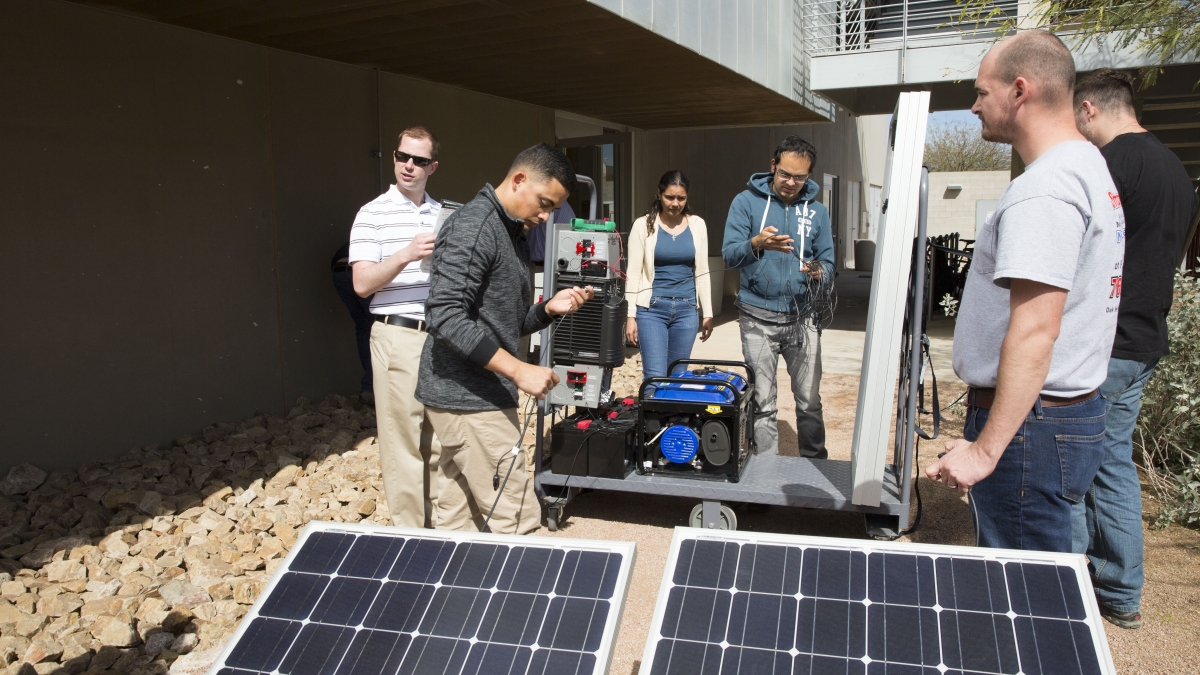UNAM team joins ASU power ‘boot camp’

UNAM doctoral students Fernanda Alvarez and Jose Fuentes, center (left to right), examine part of a microgrid solar-powered system alongside student veterans at Arizona State University’s Polytechnic campus, Wednesday, March 8, 2017, during the Microgrid Boot Camp. Photo by Peter Zrioka/ASU
The term “microgrid” may not conjure excitement in the average person, but for organizations or people that stand to lose money, life, limb or living standards due to power outages, it does.
Microgrids can keep the lights on even after main power sources fail and they were the focus of a week-long “boot camp” held at Arizona State University’s Polytechnic campus this week for military veteran students and an academic trio from Mexico City.
Two doctoral students and a professor from the Universidad Nacional Autónoma de México (UNAM) joined the event organized by the Ira A. Fulton Schools of Engineering and part of the U.S. Navy’s NEPTUNE energy research project with ASU.
“The microgrid boot camp is a 40-hour intensive, all-inclusive approach to microgrid education focusing on infrastructure basics,” said Nathan Johnson, assistant professor for the Fulton Schools at the Polytechnic campus and director of the Laboratory for Energy and Power Solutions. “This week and the involvement of UNAM is one example of how we’re taking our research and training to be a true global program. We’re on the early stages of developing global microgrid centers of excellence.”
NEPTUNE is an energy research project established with Department of Defense funding to break new ground in alternative energy while employing student veterans to assist and gain marketable skills. Veterans and other military-affiliated students are the primary audience but Johnson saw the benefit in having UNAM participate and continue the existing collaboration.
“For them to come up was more of a good opportunity,” Johnson said. “Given that UNAM and ASU have an exchange, this is part of their exchange to come work with us from an educational research standpoint. The work we’re doing with Cesár Angeles [UNAM lead professor], focuses on the problem of significant amount of solar on the grid. How do you effectively manage those with storage and advanced controls.”
Johnson said that part of the goal in partnering with UNAM is to develop energy simulations, hardware and then connecting them to “control the dial” and make sure it meets utilities’ safety and reliability requirements for one grid, and then for multiple ones connected together.
The objective of using microgrids is to provide quality, reliable stand-alone energy during a loss of power from the main grid — i.e., the main electric power infrastructure. Microgrid systems, which can be powered by solar or other energy, are being installed in hospitals, military bases, college campuses and have become very common in data centers, Johnson said. They can also be packaged and transported where needed during disaster response.
“So places that need to have 100 percent reliable power,” Johnson said. “They go down for seconds and it’s millions of dollars. For many of the small businesses and household consumers, the focus is on renewable energy and reduced electric bills.”
The boot camp included interactive tours, lessons, lectures and talks from corporate and other ASU partners. More importantly it enabled the exchange of perspectives and capabilities, a valuable aspect to the UNAM students.
“I’ve worked with photovoltaic systems, I’ve utilized these inverters, and utilized practically the same brand of panels, so it’s something that we know,” said UNAM doctoral electrical engineering student Jose Fuentes, about being familiar with some of the boot camp concepts and equipment. “What is interesting here is how easily the systems can be built and integrated quickly with the support needed to assemble everything and have it running within a semester or so.”
Another key aspect of the course is the focus on renewable energy, said Fernanda Alvarez, also a doctoral electrical engineering student at UNAM and a Colombia native.
“There are many parts in Mexico, Colombia, here and other places where due to distance or location, there isn’t quality access to energy,” Alvarez said. “Systems like these will obviously make life easier and give everyone the rightful access to electricity and quality of life.”
The Micogrid Boot Camp is one of six NEPTUNE projects at ASU. The acronym stands for Naval Enterprise Partnership Teaming with Universities for National Excellence. Locally, the program is a collaboration between ASU LightWorks, the Ira A. Fulton Schools of Engineering and the Pat Tillman Veterans Center.
More Science and technology

SpaceHACK highlights student solutions to environmental challenges, digital divide
By Adrianna Nine About 250 students from around the world convened online and at Arizona State University on March 22 for the…

New AI for a new era of discovery
As the legend goes, in 1665, Sir Isaac Newton sat in his garden at Woolsthorpe Manor in England and looked on as a lone apple…

ASU receives 3 awards for research critical to national security
Three researchers in the Ira A. Fulton Schools of Engineering at Arizona State University have received grant awards under the …